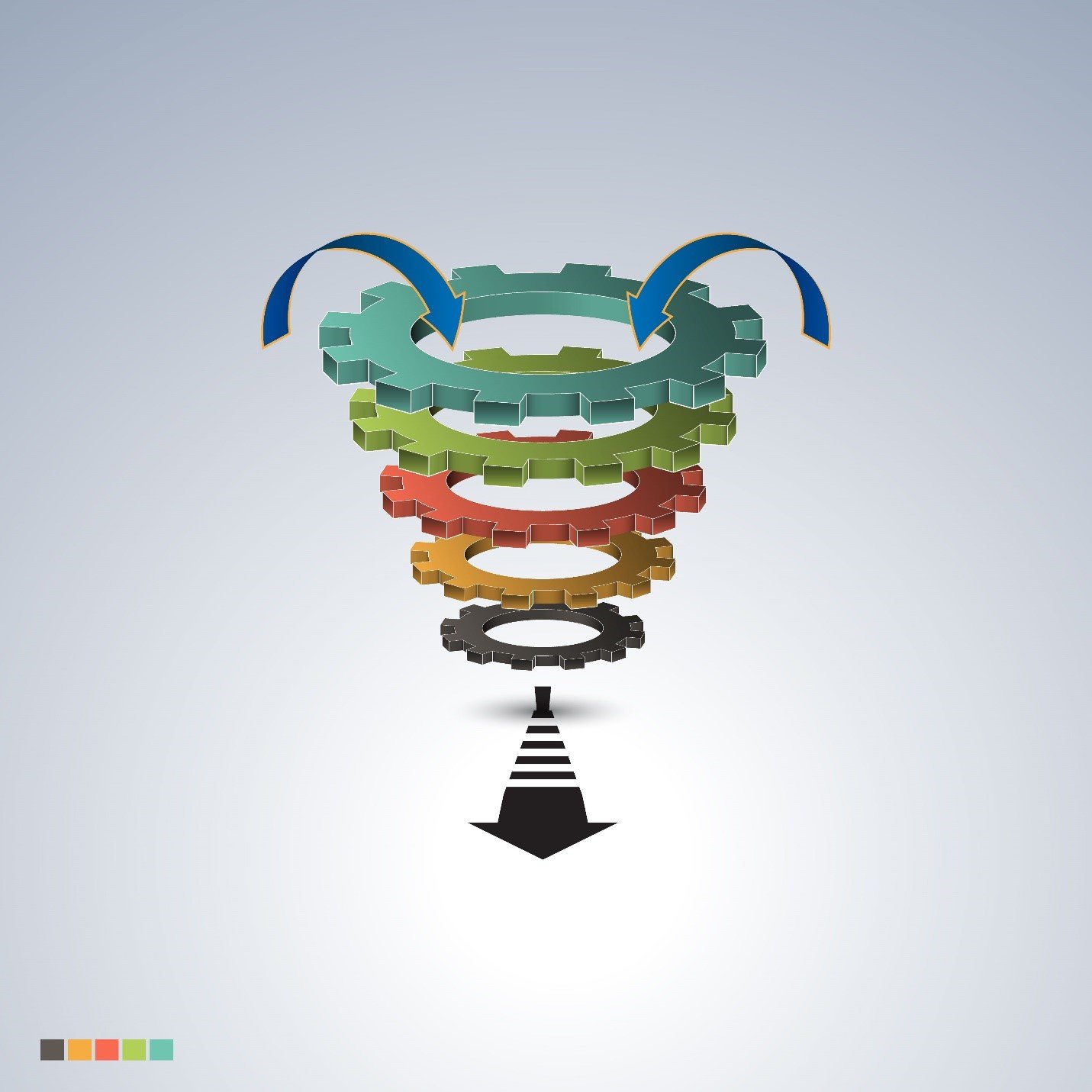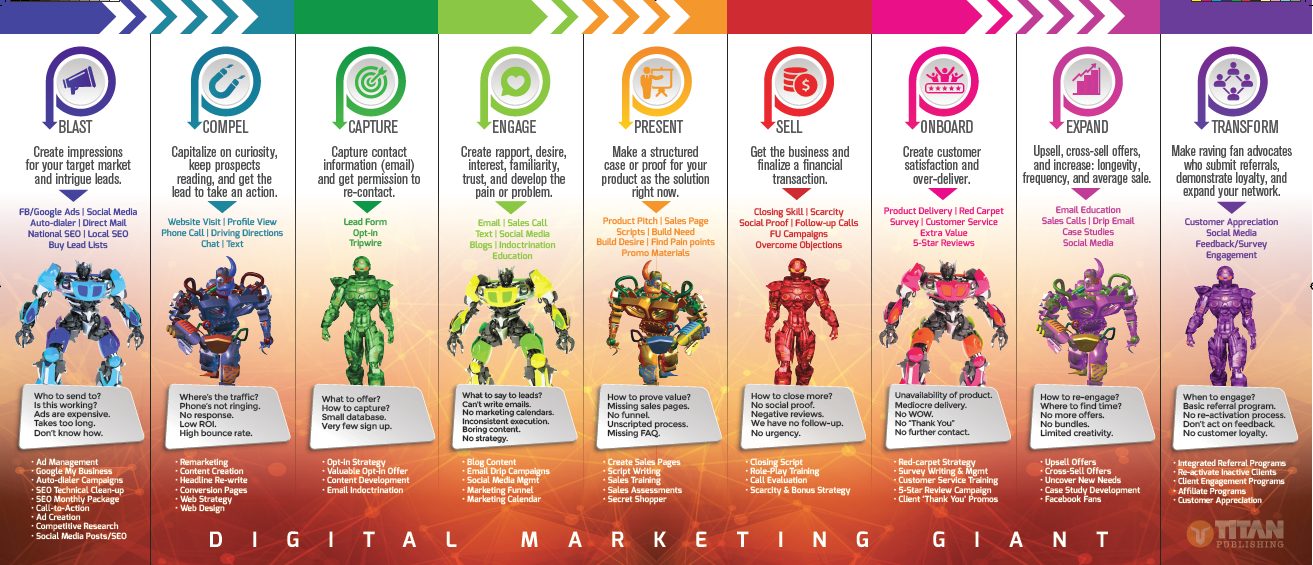Sales Funnel
The critical path to profit
Possibly the most under-rated, abused, and misunderstood concept in the history of business is the Sales Funnel Strategy. Most marketing plans are missing the necessary stepping stones to help prospects profitably make the journey from stranger to raving fan.
The sales funnel is synonymous with The Steps to a Sale or The Sales Process. Businesses would like to find a short-cut that allows a single blast (or the announcing of a product) to lead to an avalanche of sales. But the truth is that consumers need to hear a message 8.2 times (on average) before taking an action.
The question is: how to minimize the cost of taking the largest number of prospects through the funnel? Answer- understand and optimize the tactics at:
ToFu- the Top of the funnel
MoFu- the Middle of the funnel
BoFu- the Bottom of the funnel
What is the Sales Funnel?
The basic sales funnel starts with attracting new leads and ends in sales. The simplest journey is usually expressed as:
1. Attract leads
2. Convert contact information (at which time, less than 50% are ready to buy)
3. Nurture until a threshold event increases the purchase propensity
4. Close the deal

The strategy gets its name from its diagram form. The top is the largest category, which represents potential customers, followed by qualified prospects who are positioned to purchase your goods and services. The bottom category represents the smallest number-your repeat customers.
How do Sales Funnel work?
Decide strategies for achieving conversion for each successive step, one through nine. The more prospects ushered successfully through the process, the more retained earnings for the enterprise.
Blast
Entice a potential customer to visit your website through Facebook/Google ads, social media, direct mail campaigns or national SEO (search engine optimization) to name a few with an irresistible offer.
Compel
Create a great landing page to capitalize on curiosity and keep prospects reading; get the visitor to take an action. Page time creates opt-ins.
Capture
Present a front-end freebie offer to entice your visitor and require the visitor to leave contact information. Once you have an email address, you will be able to reach out to the prospect over time and be top-of-mind when he is ready to buy.
Engage
Create rapport, desire, interest, familiarity, trust, and develop the pains and problems of the prospect. Ask questions and invite the prospect’s participation. Use an indoctrination series to bring your prospect up-to-speed. Use a drip campaign to raise awareness.
Present
Make a structured case or proof for your product as the solution right now. Use a convincing product pitch, sales page, or promotional materials to educate your potential customer. Develop urgency through special offers and deadlines.
Sell
Close the deal, get the business and finalize a financial transaction. Make the right offer and attach a deadline to the deal to give a client an incentive to commit. Overcome objections by coming up with a list of anticipated problems and provide thoughtful analysis of the risks.
Onboard
Create customer satisfaction by over-delivering. Follow up with your customer to ensure they are happy with their product or service. Get lots of feedback. Customer feedback will reveal any gaps in your sales and product delivery process. It will shine a light on improvements you can make in the quality of customer service, expediting an order or delivery time. Use 5-star reviews to enhance your reputation, improve SEO, and provide social proof to future prospects.
Expand
Re-engage buyers with add-ons or upgrades. Uncover new needs for cross-sell or joint venture. Create series of offers that will deliver more benefit to your customer if he or she upgrades. Make sure to have strategies to increase longevity the customer, frequency of purchase and average transaction amount. All additional revenue dollars captured in the “expand” category carry greater profitability than the initial sale (which carries the cost to acquire the customer.)
Transform
Referrals are among the top ways a company gets leads and generates new business. Referrals present a tremendous return on investment for the marketing investment. Referrals build a seller’s trustworthiness and credibility too. Create a referral program with complimentary providers to exchange referrals. Make advocates out of your customers, who submit referrals, demonstrate loyalty, and expand your network by providing exceptional service. Recognize and thank your referral source with an email, phone call or handwritten note. It’s important to express your appreciation, which will also encourage additional referrals.
What goes wrong in the Steps to a Sale?
All businesses who engage in web and marketing activities want a potential customer to find them and to buy from them. The primary goal of a sales funnel is to move people from the “found you” stage of the process to the “buying” stage. Rushing or skipping a few steps to get to the finish line can scare a potential customer away. Asking for the sale too soon presents a mismatch to the customers readiness. Getting stuck and not advancing to the next stage leads to LODI (the Law of Diminishing Intent.) By leading a potential customer through the 9-step process, you ensure their journey will end in a sale.
Possible mistakes:
- Boring ads
- No intriguing material on the website
- Showcasing product before framing the problem
- Talking about yourself instead of the customer
- Not addressing FAQs
- Lack of education
- No opt-in offer
- No follow-up after the pitch, or after the sale
- No referral program
- Negative reviews
- No pitch
- No urgency
It’s a complicated formula to cover all the bases (at the right time) in the customer journey. Getting it right involves split-testing, knowing the industry, knowing the consumer, and a little creativity. Your effort ends in pure profit and a process that will leave your competition scratching their heads.
Do you know these Sales Funnel buzz words?
- Opt-in
- Contact form
- Traffic
- Front end offer
- Social proof
- Nurture
- Convert
- Back end offer
- Tripwire
- Auto-responder
- Lead magnet
Metrics used in Sales Funnel analysis:
- Lead generation rate
- Conversion rate
- Close rate
- Average sales cycle length
- Average ticket/transaction
- Win rate
- Frequency
- Longevity
- Referral
- Cost per Acquisition
- Cost per sale
What should I do if I want help with my Sales Funnel?
Consider making improvements to your Sales Funnel. Contact Titan Publishing for a complete map and evaluation of your sales funnel.







